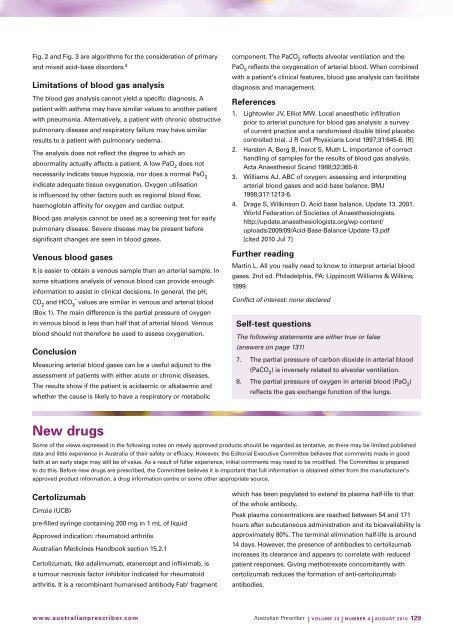The interpretation of arterial blood gases - Australian Prescriber
The interpretation of arterial blood gases - Australian Prescriber
The interpretation of arterial blood gases - Australian Prescriber
You also want an ePaper? Increase the reach of your titles
YUMPU automatically turns print PDFs into web optimized ePapers that Google loves.
Fig. 2 and Fig. 3 are algorithms for the consideration <strong>of</strong> primary<br />
and mixed acid–base disorders. 4<br />
limitations <strong>of</strong> <strong>blood</strong> gas analysis<br />
<strong>The</strong> <strong>blood</strong> gas analysis cannot yield a specific diagnosis. A<br />
patient with asthma may have similar values to another patient<br />
with pneumonia. Alternatively, a patient with chronic obstructive<br />
pulmonary disease and respiratory failure may have similar<br />
results to a patient with pulmonary oedema.<br />
<strong>The</strong> analysis does not reflect the degree to which an<br />
abnormality actually affects a patient. A low PaO 2<br />
does not<br />
necessarily indicate tissue hypoxia, nor does a normal PaO 2<br />
indicate adequate tissue oxygenation. Oxygen utilisation<br />
is influenced by other factors such as regional <strong>blood</strong> flow,<br />
haemoglobin affinity for oxygen and cardiac output.<br />
Blood gas analysis cannot be used as a screening test for early<br />
pulmonary disease. Severe disease may be present before<br />
significant changes are seen in <strong>blood</strong> <strong>gases</strong>.<br />
Venous <strong>blood</strong> <strong>gases</strong><br />
It is easier to obtain a venous sample than an <strong>arterial</strong> sample. In<br />
some situations analysis <strong>of</strong> venous <strong>blood</strong> can provide enough<br />
information to assist in clinical decisions. In general, the pH,<br />
CO 2<br />
and HCO 3ˉ values are similar in venous and <strong>arterial</strong> <strong>blood</strong><br />
(Box 1). <strong>The</strong> main difference is the partial pressure <strong>of</strong> oxygen<br />
in venous <strong>blood</strong> is less than half that <strong>of</strong> <strong>arterial</strong> <strong>blood</strong>. Venous<br />
<strong>blood</strong> should not therefore be used to assess oxygenation.<br />
Conclusion<br />
Measuring <strong>arterial</strong> <strong>blood</strong> <strong>gases</strong> can be a useful adjunct to the<br />
assessment <strong>of</strong> patients with either acute or chronic diseases.<br />
<strong>The</strong> results show if the patient is acidaemic or alkalaemic and<br />
whether the cause is likely to have a respiratory or metabolic<br />
component. <strong>The</strong> PaCO 2<br />
reflects alveolar ventilation and the<br />
PaO 2<br />
reflects the oxygenation <strong>of</strong> <strong>arterial</strong> <strong>blood</strong>. When combined<br />
with a patient's clinical features, <strong>blood</strong> gas analysis can facilitate<br />
diagnosis and management.<br />
References<br />
1. Lightowler JV, Elliot MW. Local anaesthetic infiltration<br />
prior to <strong>arterial</strong> puncture for <strong>blood</strong> gas analysis: a survey<br />
<strong>of</strong> current practice and a randomised double blind placebo<br />
controlled trial. J R Coll Physicians Lond 1997;31:645-6. [R]<br />
2. Harsten A, Berg B, Inerot S, Muth L. Importance <strong>of</strong> correct<br />
handling <strong>of</strong> samples for the results <strong>of</strong> <strong>blood</strong> gas analysis.<br />
Acta Anaesthesiol Scand 1988;32:365-8.<br />
3. Williams AJ. ABC <strong>of</strong> oxygen: assessing and interpreting<br />
<strong>arterial</strong> <strong>blood</strong> <strong>gases</strong> and acid-base balance. BMJ<br />
1998;317:1213-6.<br />
4. Drage S, Wilkinson D. Acid base balance. Update 13. 2001.<br />
World Federation <strong>of</strong> Societies <strong>of</strong> Anaesthesiologists.<br />
http://update.anaesthesiologists.org/wp-content/<br />
uploads/2009/09/Acid-Base-Balance-Update-13.pdf<br />
[cited 2010 Jul 7]<br />
Further reading<br />
Martin L. All you really need to know to interpret <strong>arterial</strong> <strong>blood</strong><br />
<strong>gases</strong>. 2nd ed. Philadelphia, PA: Lippincott Williams & Wilkins;<br />
1999.<br />
Conflict <strong>of</strong> interest: none declared<br />
Self-test questions<br />
<strong>The</strong> following statements are either true or false<br />
(answers on page 131)<br />
7. <strong>The</strong> partial pressure <strong>of</strong> carbon dioxide in <strong>arterial</strong> <strong>blood</strong><br />
(PaCO 2<br />
) is inversely related to alveolar ventilation.<br />
8. <strong>The</strong> partial pressure <strong>of</strong> oxygen in <strong>arterial</strong> <strong>blood</strong> (PaO 2<br />
)<br />
reflects the gas exchange function <strong>of</strong> the lungs.<br />
New drugs<br />
Some <strong>of</strong> the views expressed in the following notes on newly approved products should be regarded as tentative, as there may be limited published<br />
data and little experience in Australia <strong>of</strong> their safety or efficacy. However, the Editorial Executive Committee believes that comments made in good<br />
faith at an early stage may still be <strong>of</strong> value. As a result <strong>of</strong> fuller experience, initial comments may need to be modified. <strong>The</strong> Committee is prepared<br />
to do this. Before new drugs are prescribed, the Committee believes it is important that full information is obtained either from the manufacturer's<br />
approved product information, a drug information centre or some other appropriate source.<br />
Certolizumab<br />
Cimzia (UCB)<br />
pre-filled syringe containing 200 mg in 1 mL <strong>of</strong> liquid<br />
Approved indication: rheumatoid arthritis<br />
<strong>Australian</strong> Medicines Handbook section 15.2.1<br />
Certolizumab, like adalimumab, etanercept and infliximab, is<br />
a tumour necrosis factor inhibitor indicated for rheumatoid<br />
arthritis. It is a recombinant humanised antibody Fab' fragment<br />
which has been pegylated to extend its plasma half-life to that<br />
<strong>of</strong> the whole antibody.<br />
Peak plasma concentrations are reached between 54 and 171<br />
hours after subcutaneous administration and its bioavailability is<br />
approximately 80%. <strong>The</strong> terminal elimination half-life is around<br />
14 days. However, the presence <strong>of</strong> antibodies to certolizumab<br />
increases its clearance and appears to correlate with reduced<br />
patient responses. Giving methotrexate concomitantly with<br />
certolizumab reduces the formation <strong>of</strong> anti-certolizumab<br />
antibodies.<br />
www.australianprescriber.com<br />
| Volume 33 | NumBeR 4 | AuGuST 2010 129
















